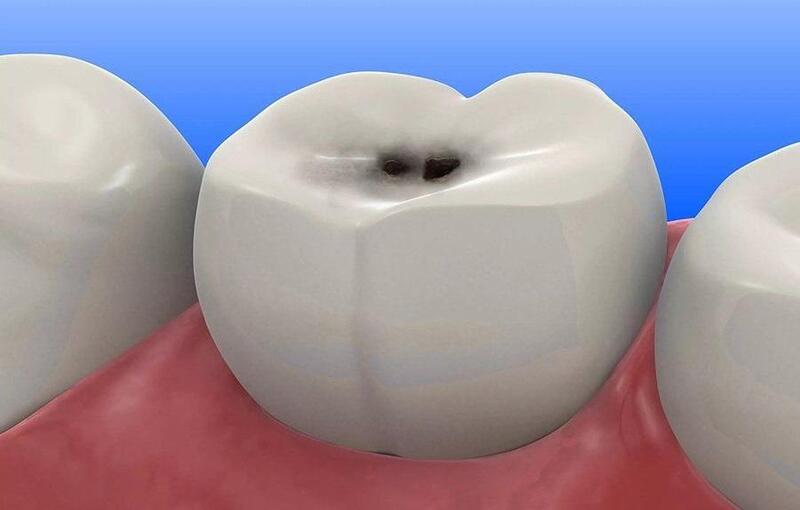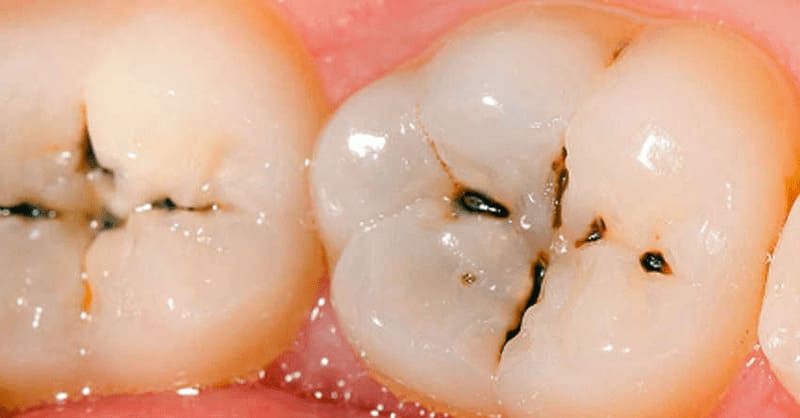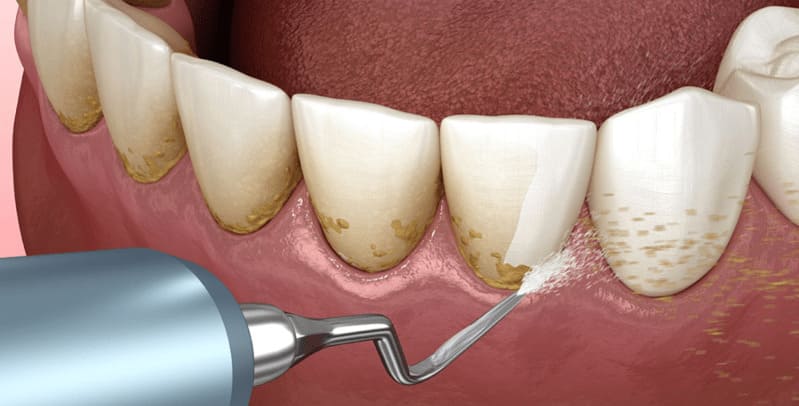Tooth Stains

The leading causes of discoloured enamel are tooth stains or tooth decay. The natural colour of the tooth coating varies from milky white to slightly yellowish. Brown, black, grey, white, and pink spots, stains or streaks signal health problems.
It is difficult to determine what caused the tooth surface metamorphosis without professional help. Similar external signs may be due to different processes in your mouth or body. If you notice a change in the natural colour of the enamel, you should consult the dentist to find the reasons.

Tooth stains are the discolouration of tooth enamel. Usually, they do not affect the protective properties of the tooth coating, but sometimes they may indicate the onset of a disease. Cavities demineralisation and subsequent softening of enamel and dentin with cavity formation.
The problem worsens over time; the “tooth construction material” gets increasingly decayed, and the cavity is filled with bacteria causing pulpitis, periodontitis, periodontal disease and eventually tooth loss.
The leading causes of black stains on teeth are
- tooth decay;
- age-related changes;
- gastrointestinal, circulatory or endocrine system diseases, infections or intoxications;
- fluorosis (excess fluoride);
- certain types of medication, e.g. tetracyclines or iron;
- demineralization due to wearing braces;
- consumption of brightly colored foods and drinks (berries, coffee, tea), smoking;
- plaque and poor oral hygiene;
- heredity;
- pathological changes in the root canals;
- poor quality fillings or prosthetic work;
- lack of vitamins and minerals in the diet.
During check-ups and oral examinations, the dentist will analyze the amount and location of black stains on the teeth (upper part of the crown, gum area) and the number of affected teeth, assess the general health of the patient and find out what medications the patient takes. After establishing the diagnosis and determining the cause of the problem, a dental specialist chooses a method of prevention or treatment.

Statistics show that 80% of school-age children and almost 100% of adults suffer from dental cavities. In addition, 95% of the population suffers from periodontal disease. Up to 30% of people over 65 do not have natural teeth.
Often, dark spots on the teeth occur at an early age. It is common for many dental elements to be affected at once. In this case, cavities are the most common cause.
Enamel on baby teeth is very thin, and the pathological process develops quickly at the slightest damage. It occurs due to the following:
- poor oral hygiene;
- consumption of unhealthy foods (desserts, snacks, fizzy drinks);
- the habit of constantly snacking on biscuits and sweets, falling asleep with a dummy and a milk bottle.
To keep teeth healthy, it is essential to solving the problem immediately. You need to schedule a dental check-up as soon as possible.
Black Lines on Tooth Fissures
Under normal conditions, the fissures (the natural pits or grooves in the top part of the crown) are slightly darker in colour than the enamel. It is due to pathology if they turn dark brown or black.
A buildup of food debris in the cavities and poor oral hygiene causes this. In addition, poor cleaning of the occlusal surface causes the growth of bacteria that can destroy the enamel.

To differentiate between cavities and stains, the dentist probes the surface with a particular instrument, or the patient may be recommended to have an x-ray. If the enamel in the fissure area is healthy, hard and strong, you can hear a typical creaking sound when the probe is applied.
If the probe fails in the cavity, the tooth coating is softened; this is the initial decay stage. In this case, it is necessary to fill the cavity that has formed. Indirect symptoms of tooth decay are sensitivity to hot or cold foods and drinks and occasionally a nagging ache.
The pits can be a groove, funnel or drop-shaped. Narrow and deep pits are difficult to clean, and sooner or later, cavities may develop. In addition, the enamel is very thin here, contributing to the rapid occurrence of caries lesions.
To prevent disease development, it is necessary to
- intensify oral hygiene;
- have your teeth professionally cleaned at your dentist’s office every six months;
- conduct a fissure sealing procedure (with a filling material).
Fissure sealing is most effective during childhood, in the first six months after the full eruption of the tooth. The process is non-traumatic and painless and allows one to live an everyday life immediately. The filling material lasts 5-10 years; later, the patient can repeat the procedure. In the case of the initial stage of tooth decay, a dentist treats the tooth before the fissures sealing.
Dark Spots Inside Mouth
Most black spots on the teeth indicate the initial stage of dental cavities. The larger they are, the more affected the enamel and dentin are. Light brown spots on the sides of the teeth are a sign of erosion. This non-carious lesion widens and deepens over time and darkens with exposure to drinks and food. Another cause of the dark spots is plaque and tartar buildup, which, over time, turns into a dark brown colour.
In areas where the water contains high fluoride levels, people may develop fluorosis, which manifests as dark stains on the teeth. In the initial stages of the disease, professional whitening followed by remineralisation is sufficient.
A dentist can restore the enamel mineral content by applying phosphorus and calcium compounds. Professional oral hygiene at the dentist’s office is recommended to prevent the recurrence. It is recommended to apply special remineralising toothpaste at home after that occasionally. It is essential to change the diet to reduce phosphorus-containing food and drink clean potable water.

Professional oral hygiene to remove dark spots on teeth covers different methods:
- laser;
- airflow;
- ultrasound;
- chemical;
- mechanical.
The choice of cleaning method depends on the condition of the tooth enamel and oral diseases; a dentist chooses it individually.

Dark Lines on Teeth
The causes of dark lines on the teeth depend on their location. If the defect is visible on the upper part of the crown or the chewing surface, it is the initial stage of decay. Then, the dentist can treat the problem (fissure sealing, cavity filling).
If the dark lines are on the bottom of the tooth, next to the gum line, this is usually pigmentation (age-related or caused by smoking or eating stained foods). In this case, a professional hygiene cleaning and the subsequent selection of proper preventive care would suffice.
Sometimes the cause of the discolouration is not poor but excessive dental hygiene. For example, the darkening may be caused by the wrong toothpaste or rinse.
Another common reason for brown lines on teeth is a gastrointestinal problem (intestinal dysbacteriosis). In this case, consultation with a gastroenterologist, treatment of the underlying disease and correction of diet is necessary.
If the enamel’s darkening is caused by medication, it is necessary to consult your doctor and find an analogue that does not cause such changes.
As we age, our tooth enamel becomes thinner, and the dentin begins to show through. Visually, it also looks like dark spots and lines on the teeth. So brushing or bleaching is not the answer. Instead, dental restorations, crowns, veneers or lumineers can be fitted.
A few decades ago, dentists used fillings that caused the adjacent enamel to darken over time. To correct this defect, dental specialists recommend using modern photopolymers for restoration.
Often tartar causes discolouration in the teeth’ root areas. This problem can lead to periodontitis (inflammatory disease of the tissues surrounding the tooth). Apart from the dark buildup, signs of tooth decay include red and bleeding gums, bad breath, loose teeth and increased tooth enamel sensitivity. Therefore, regular dental check-ups and removal of plaque and tartar are necessary to prevent periodontal disease.
If you have stains on your teeth, do not expect them to disappear. It is recommended to see a doctor immediately to find out the cause and methods of its elimination. Timely treatment will guarantee quick problem elimination and a perfect smile.
To keep your teeth beautiful and healthy, you should see a doctor every six months, keep an eye on your health, practice good hygiene, choose a healthy diet and avoid unhealthy habits.


